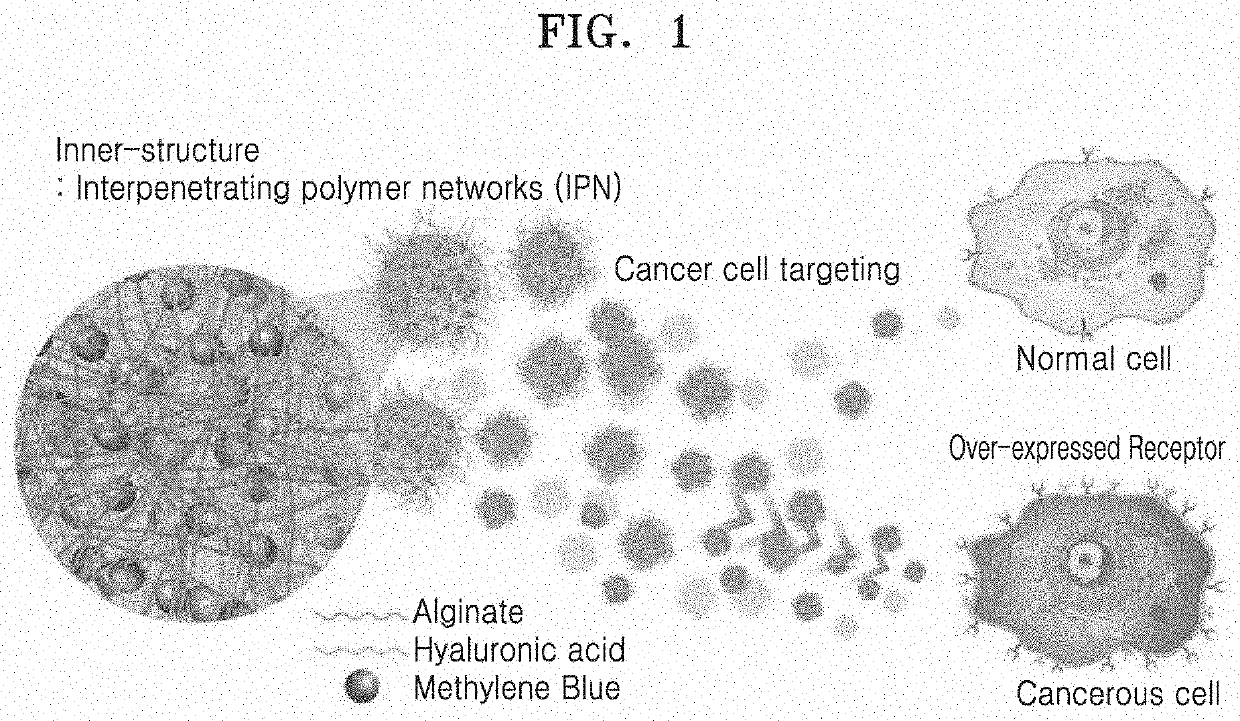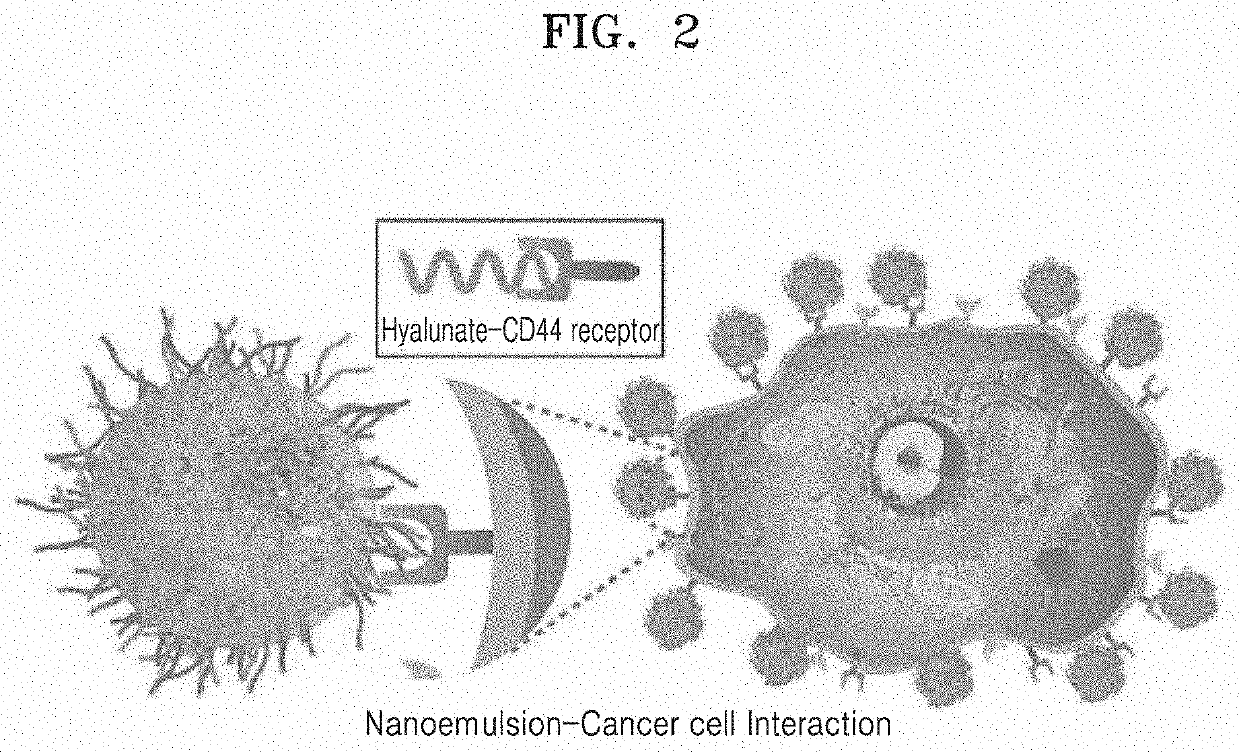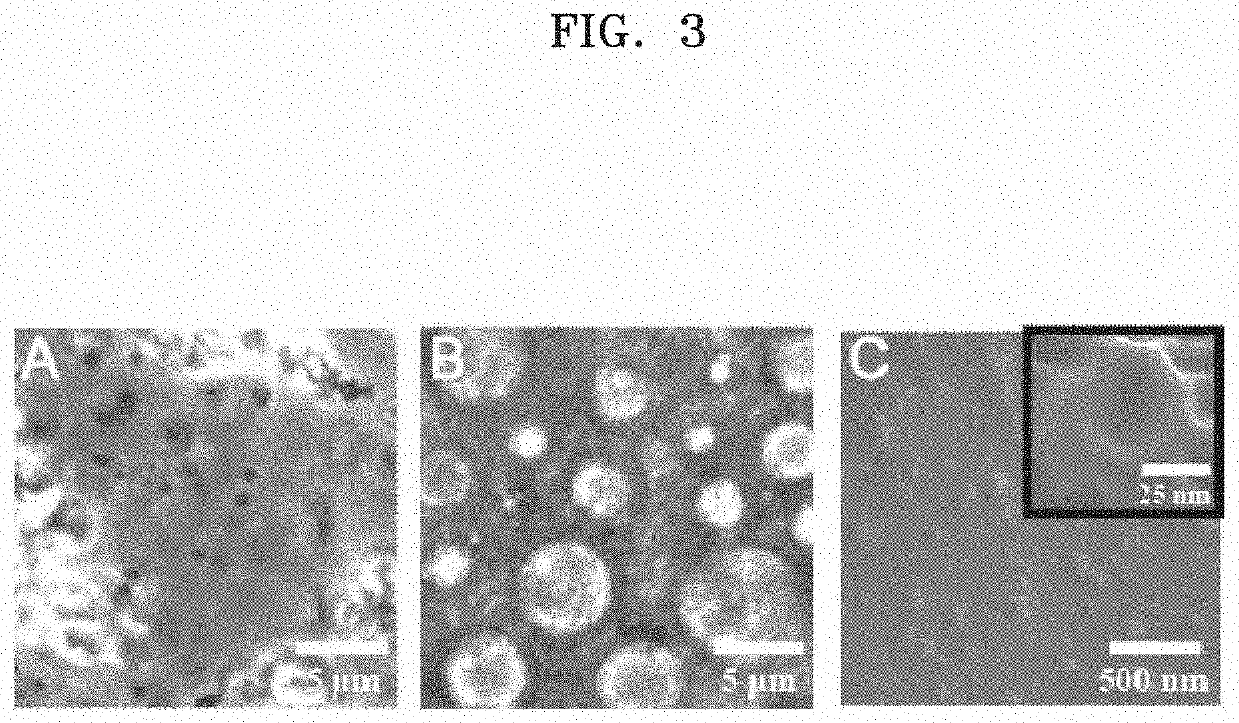Hydrogel-based nanoenulsion for selectively labeling cancer lesion, and preparation method therefor
a technology of cancer lesion and nanoemulsion, which is applied in the direction of luminescence/biological stain preparation, dispersed delivery, instruments, etc., can solve the problems of accurate diagnosis, dysplasia and early-stage cancer diagnosis, etc., to maximize the therapeutic effect of cancer, facilitate early diagnosis, and efficiently deliver
- Summary
- Abstract
- Description
- Claims
- Application Information
AI Technical Summary
Benefits of technology
Problems solved by technology
Method used
Image
Examples
preparation example 1
ulsion 1
[0081]Hyaluronic acid (Research grade from Lifecore, MW=41-65 kDa) and purified soybean oil (Sigma) were prepared. A methylene blue solution (Sigma) certified for microscopy by the Biological Staining Commission (BSC) was prepared. Span 80 (HLB value 4.3: Sigma) and Tween 80 (HLB value 15: Sigma) which are surfactants suitable for cell culture were prepared. Surfactants having different hydrophilic-lipophilic balance values as shown in the following Table were prepared by controlling a weight ratio of Span 80 to Tween 80.
[0082]An oil component (soybean oil) containing the prepared surfactant, a first aqueous component (0.5% sodium alginate and 0.5% sodium hyaluronate (w / w)), and a second aqueous component (contrast agent: 10 mM methylene blue solution or 10 mM indigo carmine solution) were prepared, respectively.
[0083]A mixed solution containing the oil component:surfactant:first aqueous component:second queous component at a weight ratio of 70:10:10:10 was stirred and mixed...
preparation example 2
ulsion 2
[0085]A nanoemulsion was prepared in the same manner as in Preparation Example 1, except that the weight ratio of oil component:surfactant:aqueous component was controlled at 8:1:1 instead of 7:1:2 in Preparation Example 1.
experimental example 1
[0086]Particle size, particle size distribution (PDI), and zeta potential of the nanoemulsions prepared in Preparation Examples 1 and 2 were measured using a nanoparticle analyzer (Dynamic light scattering), and results are shown in Table 1 below.
[0087]
TABLE 1oil component / surfactant / aqueousDay 0Co-surfactantcomponentSizeZPSampleHLB valueratio(wt %)(nm, DLS Z-avg)PDI(mV)NE a57:1:288.62 ± 7.01 0.650 ± 0.10−22.22 ± 0.71NE b612.10 ± 17.680.448 ± 0.12−46.01 ± 0.44NE c715.18 ± 0.90 0.417 ± 0.06−22.24 ± 0.58NE d842.12 ± 23.530.418 ± 0.05−24.64 ± 0.39NE e58:1:159.12 ± 18.250.588 ± 0.06−43.30 ± 0.26NE f655.96 ± 29.710.312 ± 0.03−46.17 ± 0.35NE g744.69 ± 22.780.295 ± 0.03−44.20 ± 0.72NE h861.25 ± 16.6 0.536 ± 0.13−27.77 ± 0.25
[0088]The results of Table 1 showed that the size of nanoemulsion may be controlled by controlling the hydrophilic-lipophilic balance values of the nanoemulsions.
PUM
| Property | Measurement | Unit |
|---|---|---|
| particle size | aaaaa | aaaaa |
| PDI | aaaaa | aaaaa |
| weight ratio | aaaaa | aaaaa |
Abstract
Description
Claims
Application Information
 Login to View More
Login to View More - R&D
- Intellectual Property
- Life Sciences
- Materials
- Tech Scout
- Unparalleled Data Quality
- Higher Quality Content
- 60% Fewer Hallucinations
Browse by: Latest US Patents, China's latest patents, Technical Efficacy Thesaurus, Application Domain, Technology Topic, Popular Technical Reports.
© 2025 PatSnap. All rights reserved.Legal|Privacy policy|Modern Slavery Act Transparency Statement|Sitemap|About US| Contact US: help@patsnap.com



